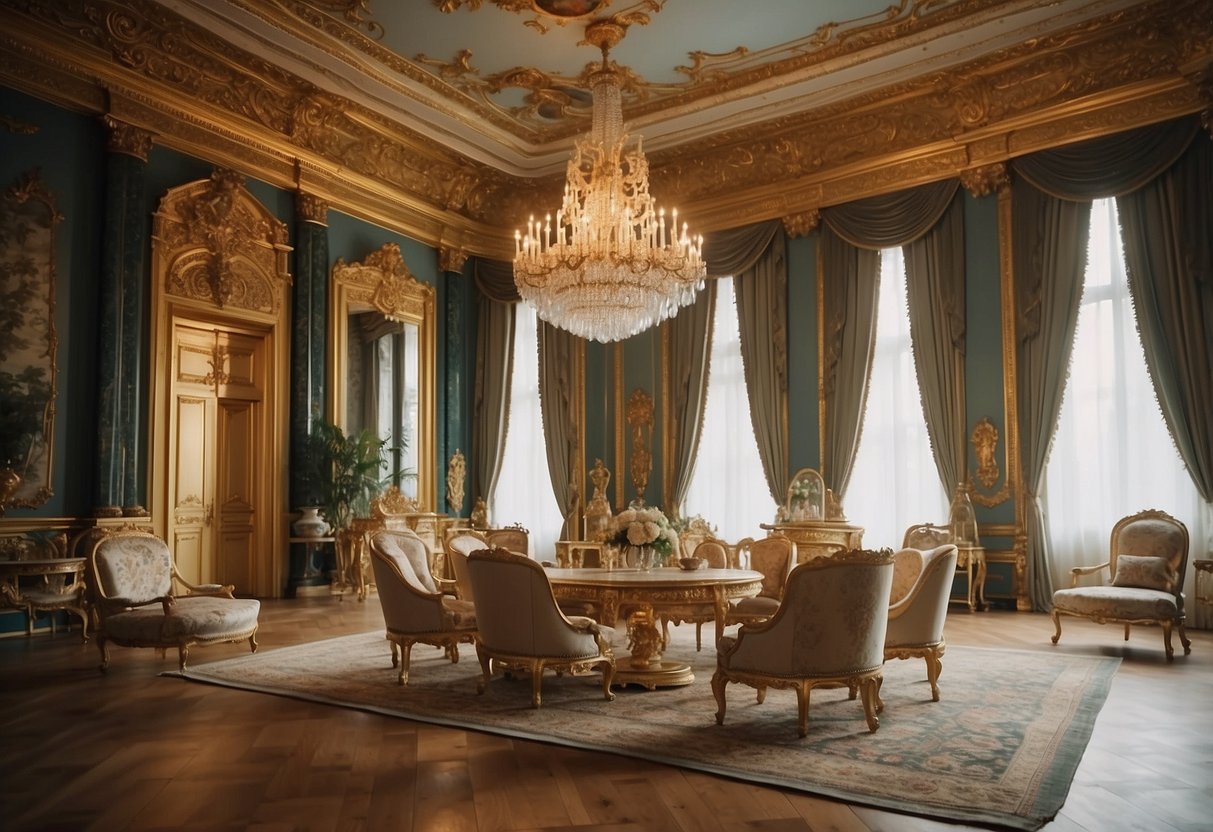Introduction
Catherine the Great, Empress of Russia from 1762 to 1796, is renowned not only for her political and cultural achievements but also for her profound influence on the arts and furniture design. Her reign marked a golden age for Russian art and culture, characterized by opulence, sophistication, and a distinctive blend of European styles. This article delves into the magnificent furniture legacy of Catherine the Great, exploring the history, styles, and lasting impact of her exquisite furniture collection.
Catherine the Great: A Brief Biography
Catherine the Great, born Sophie Friederike Auguste von Anhalt-Zerbst in 1729, was a Prussian princess who became the longest-reigning female ruler of Russia. Her marriage to Grand Duke Peter of Holstein-Gottorp brought her to the Russian court, where she eventually staged a coup to become Empress after her husband’s unpopular rule. Catherine’s reign from 1762 to 1796 was marked by vast territorial expansion, internal reforms, and significant contributions to the arts and culture.
The Influence of European Styles
Catherine the Great’s furniture collection was heavily influenced by contemporary European styles. The French Rococo style, characterized by its ornate decorations and asymmetrical designs, was particularly popular in her early reign. As her tastes evolved, she embraced Neoclassicism, inspired by the art and architecture of ancient Greece and Rome. This style, with its emphasis on symmetry, clean lines, and classical motifs, became a hallmark of her later collections. The influence of Louis XVI of France is also evident in many of her furniture pieces, reflecting the close cultural ties between Russia and France during her reign.
Patronage of the Arts
Catherine the Great was a great patron of the arts, providing support to numerous artists, craftsmen, and architects. She established workshops within her palaces and imported European furniture to enhance her collection. By fostering artistic talent and encouraging the exchange of ideas, she helped create a unique blend of European and Russian styles. Her support extended to the acquisition of entire collections from abroad, enriching the cultural heritage of Russia.
Characteristics of Catherine the Great’s Furniture
Catherine’s furniture was known for its opulence and luxury. Pieces often featured gold gilding, precious materials like marble and ivory, and intricate carvings. The use of rich fabrics such as silk and velvet for upholstery added to the lavishness. Each piece was meticulously crafted to reflect her status and taste, combining functionality with aesthetic appeal. The attention to detail in the carvings, inlays, and overall design made her furniture some of the most exquisite of the era.
Iconic Pieces of Furniture
Among the most iconic pieces associated with Catherine the Great is the Amber Room, originally installed in the Catherine Palace. This masterpiece of baroque art featured panels of amber, gold leaf, and mirrors. Unfortunately, it was looted during World War II and its whereabouts remain a mystery. Other notable pieces include gilded chairs and tables, often adorned with mythological motifs, and marble-top commodes showcasing intricate marquetry.
Furniture in the Hermitage Museum
The State Hermitage Museum in St. Petersburg houses a significant portion of Catherine the Great’s furniture collection. Highlights include her private study, decorated in the French Rococo style, and the grand halls furnished with Neoclassical pieces. The museum undertakes extensive restoration efforts to preserve these historical treasures, making them accessible to the public through exhibitions and educational programs.
Influence on Russian Furniture Design
Catherine the Great’s patronage had a lasting impact on Russian furniture design. Her adoption of European techniques and styles encouraged Russian craftsmen to innovate and develop unique interpretations. This led to the creation of distinctive Russian styles that combined European elegance with local craftsmanship. The influence of her collection can be seen in the works of subsequent Russian rulers and in the broader development of Russian decorative arts.
Catherine the Great’s Palaces
Catherine the Great’s love for grandeur and opulence is evident in her palaces. The Winter Palace, the Catherine Palace, and Peterhof Palace are prime examples of her taste and style. Each palace was lavishly decorated with exquisite furniture, artworks, and architectural elements. These residences served not only as royal homes but also as showcases of Russian power and cultural sophistication.
Notable Craftsmen and Workshops
Catherine the Great collaborated with some of the most renowned craftsmen of her time. French artisans such as Charles Boulle and André-Charles Boulle influenced the design and craftsmanship of her furniture. Additionally, Russian workshops established under her patronage produced exceptional pieces, blending European techniques with Russian artistry. These collaborations resulted in a rich and diverse collection that showcased the best of both worlds.
Materials and Techniques Used
The furniture of Catherine the Great was crafted using a variety of materials and techniques. High-quality woods like mahogany and walnut were commonly used, often embellished with gilding and marquetry. Techniques such as veneer work, carving, and inlay were employed to create intricate patterns and designs. Upholstery in luxurious fabrics added a final touch of elegance to each piece.
The Amber Room: A Case Study
The Amber Room, often referred to as the “Eighth Wonder of the World,” is a remarkable example of Catherine the Great’s taste for luxury. Originally constructed in the 18th century, it was relocated to the Catherine Palace during her reign. The room was adorned with amber panels, gold leaf, and mirrors, creating a stunning visual effect. Its disappearance during World War II remains one of the greatest mysteries of art history, and efforts to reconstruct it have been ongoing since the 1970s.
The Role of Furniture in Court Life
In Catherine the Great’s court, furniture played a significant role in both ceremonial functions and daily life. Ceremonial furniture, such as thrones and grand tables, symbolized the power and status of the monarchy. Everyday pieces, while still luxurious, were designed for comfort and practicality. The intricate design and opulence of the furniture reflected the sophistication and wealth of the Russian court.
Legacy and Historical Significance
Catherine the Great’s furniture legacy is not only a testament to her personal taste but also a reflection of her broader cultural impact. Her patronage of the arts and commitment to excellence in craftsmanship influenced furniture design for generations. The preservation of her collection allows us to appreciate the artistry and skill of the period, providing valuable insights into the cultural and social history of her reign.
Comparisons with Contemporary European Furniture
While Catherine the Great’s furniture was heavily influenced by contemporary European styles, it also featured unique adaptations that set it apart. The incorporation of Russian motifs and techniques added a distinct flair to the pieces. Comparisons with the furniture of other European monarchs, such as Louis XVI of France, reveal both similarities in style and notable differences in execution and design.
Catherine the Great’s Personal Taste
Catherine’s personal taste played a crucial role in shaping her furniture collection. Her preference for opulence, elegance, and classical beauty is evident in the pieces she commissioned. Her involvement in the design process ensured that each item reflected her vision and taste, making her collection a true representation of her aesthetic sensibilities.
Preservation and Conservation Efforts
Preserving the furniture of Catherine the Great poses significant challenges due to the age and delicacy of the pieces. Restoration techniques include careful cleaning, repairing structural damage, and conserving original materials. These efforts are essential to maintain the historical integrity of the collection and to continue sharing it with future generations.
Modern Interpretations and Inspirations
The furniture of Catherine the Great continues to inspire modern designers. Elements of her style, such as intricate carvings, gilding, and luxurious materials, are echoed in contemporary pieces. Homages to her legacy can be found in modern furniture collections, reflecting the enduring fascination with her opulent and sophisticated taste.
The Importance of Furniture in Historical Studies
Furniture from the reign of Catherine the Great provides valuable insights into the cultural and social history of the period. As historical artifacts, these pieces offer a glimpse into the lifestyles and preferences of the Russian court. Studying furniture helps historians understand the broader context of art, design, and craftsmanship during her reign.
Frequently Asked Questions
What styles influenced Catherine the Great’s furniture?
Catherine the Great’s furniture was influenced by French Rococo and Neoclassicism, as well as the designs of Louis XVI.
Where can I see Catherine the Great’s furniture collection?
A significant portion of her collection is housed in the State Hermitage Museum in St. Petersburg, Russia.
What materials were commonly used in her furniture?
High-quality woods like mahogany and walnut, along with gilding, marble, and luxurious fabrics, were commonly used.
What happened to the Amber Room?
The Amber Room was looted during World War II and its whereabouts remain unknown, though efforts to reconstruct it have been ongoing.
How did Catherine the Great influence Russian furniture design?
Her patronage encouraged the adoption of European techniques and the development of unique Russian styles, impacting subsequent craftsmanship.
Why is Catherine the Great’s furniture historically significant?
Her collection reflects her cultural impact and provides insights into the art and lifestyle of her reign, influencing furniture design for generations.
Conclusion
Catherine the Great’s furniture legacy is a remarkable testament to her refined taste, cultural patronage, and influence on art and design. Her exquisite collection, blending European elegance with Russian craftsmanship, continues to inspire and captivate. Through preservation efforts and ongoing studies, the magnificence of her furniture endures, offering a window into the opulence and sophistication of her reign.




